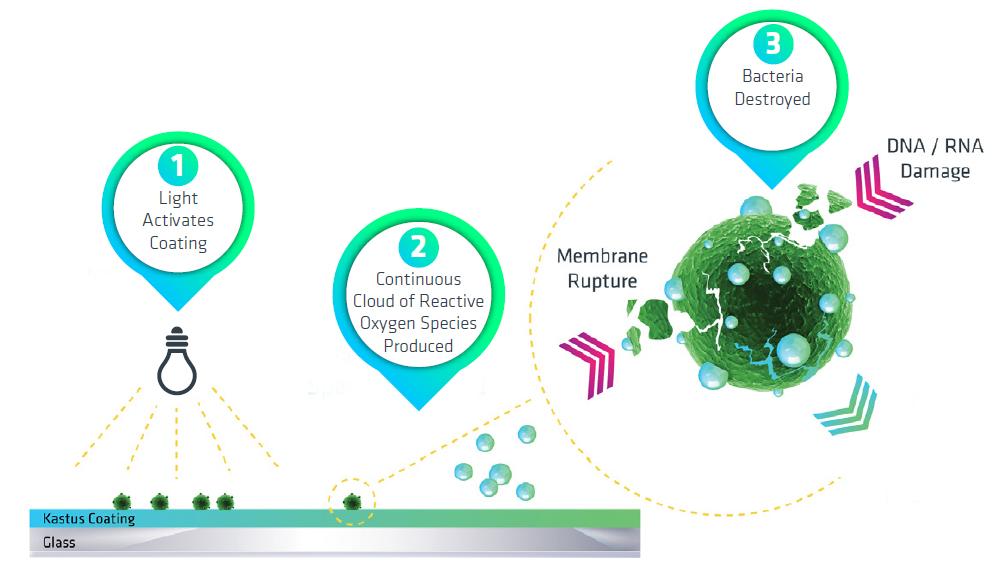For the foreseeable future, our safety depends on minimising avoidable interactions with other human beings. Long before the pandemic, however, human interaction had already been driven out of many daily activities, such as paying for groceries, buying tickets for public transport, finding directions in shopping malls, checking-in at places such as hotels or medical centres, and entering office buildings.
We’re all familiar with using touchscreens in these contexts. However, while they can help us avoid direct contact with other people, harmful organisms can survive on the surface and be transferred between users.

Touchscreens for controlling machinery, office equipment, and home appliances, can also be a danger. Strict cleaning, to sanitise areas such as supermarket checkouts, has become extremely important to help commercial organisations reassure their customers and comply with government guidelines.
However, frequent cleaning is labour-intensive and time consuming. Moreover, in some situations, it is simply not practicable for staff to sanitise touchscreens before or after every use. Leaving the task to individual users, perhaps by providing alcohol swabs with a request to wipe clean after their transaction, is not a reliable way to protect the public.
What if Touchscreens Could Sanitise Themselves?
A more effective solution would be for the existing touchscreen to sanitise itself. We can now achieve this by either integrating new touchscreen glass or aftermarket glass screen protectors that have been enhanced by a dual “always on” antimicrobial (or antibacterial) and antiviral coating technology. At Anders, we are working with world-leading brand Kastus® to offer this solution as a new or retrofittable solution for our customers. Kastus is a patented, scientifically proven technology and remains effective and maintenance-free for the lifetime of the touchscreen or screen protector. Of course, the screen’s touch-detection capability is unaffected.
How Does the Antimicrobial & Antiviral coating technology work?
Kastus® glass coating technology is primarily powered by the process of photocatalysis, as shown by this illustration below. Natural light activates the photocatalytic coating to produce a continuous cloud of reactive oxygen species that attacks the microbe DNA. Protection is thus “always on” and is proven to be effective against viruses such as Coronavirus and a host of common viruses such as Influenza A and Hepatitis A, plus surface bacteria including SA and E. coli.
The photocatalytic material is applied to the screen protector glass as a liquid coating, using airless spray systems, and sintered at 6-700°C. Whereas ordinary formulas become damaged at elevated temperatures, Kastus® technology is designed to withstand the high temperatures used in tempered glass production. The coating is extremely thin, durable and clear, with over 99% transmittance. It is also hydrophilic, making the surface easy to wipe clean for a smart appearance.

Image shows the Kastus® 24/7 AntiMicrobial coating works (courtesy of Kastus)
What is the Size Range for Kastus®’ Antimicrobial & Antiviral glass touchscreen technology?
We are now ready to integrate antimicrobial glass into new designs to combine enhanced safety with all the traditional benefits of today’s slick, colourful, graphical user interfaces. We can offer two solutions: Kastus’® antimicrobial and antiviral protection benefits as a super-thin tempered glass screen protector in sizes from 4” to 34” diagonal, which is adhered to the underlying screen. Ideal for convenient retrofitted safety in applications such as touchscreen kiosk and self-service screens. For new screens, the Kastus Technology can be applied to the glass at point of manufacture and allows glass thickness from 1.1mm to 5mm and even thicker if needed. Additional coatings such as anti-glare can be applied without compromising antimicrobial and antiviral action.
What is the Best Way to Design an enhanced Antimicrobial & Antiviral Touchscreen?
While the prospects for intrinsically safe touchscreens leveraging antimicrobial & antiviral glass are very exciting, let’s not forget the other elements that must come together to make a great design, such as proper consideration of the operating environment for reliability and readability, optimising the display and touchscreen-control capabilities of the host embedded system, managing power consumption, and the physical integration of the display.
You can trust Anders to make sure these are always covered, delivering a result that is not only safe but is also durable, attractive, and delivers a compelling user experience every time.


